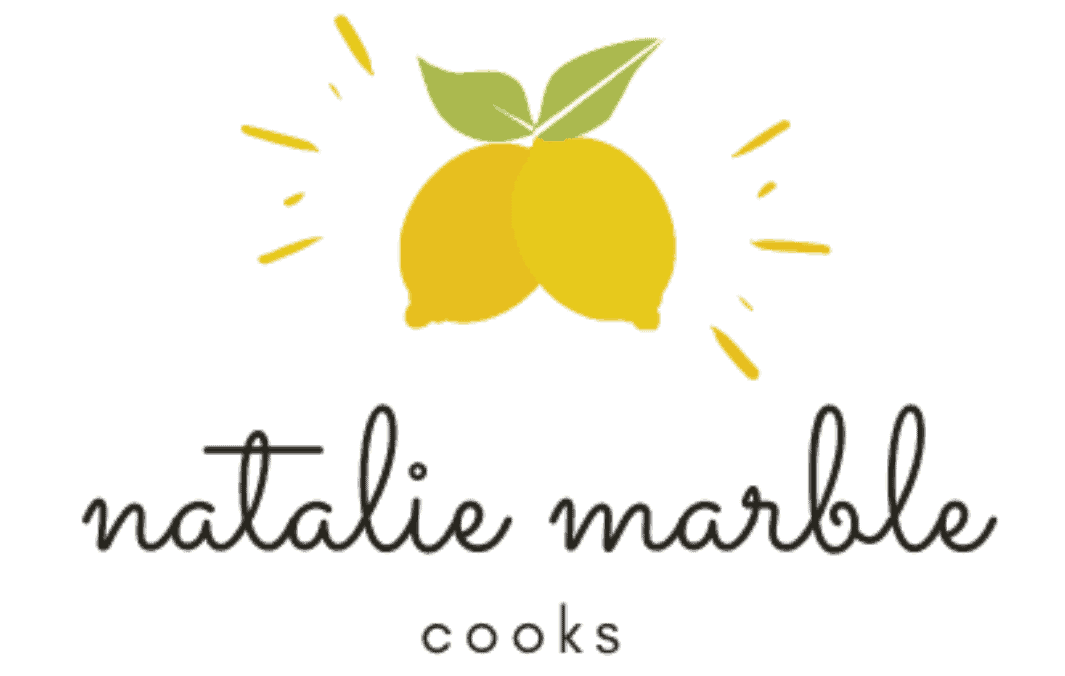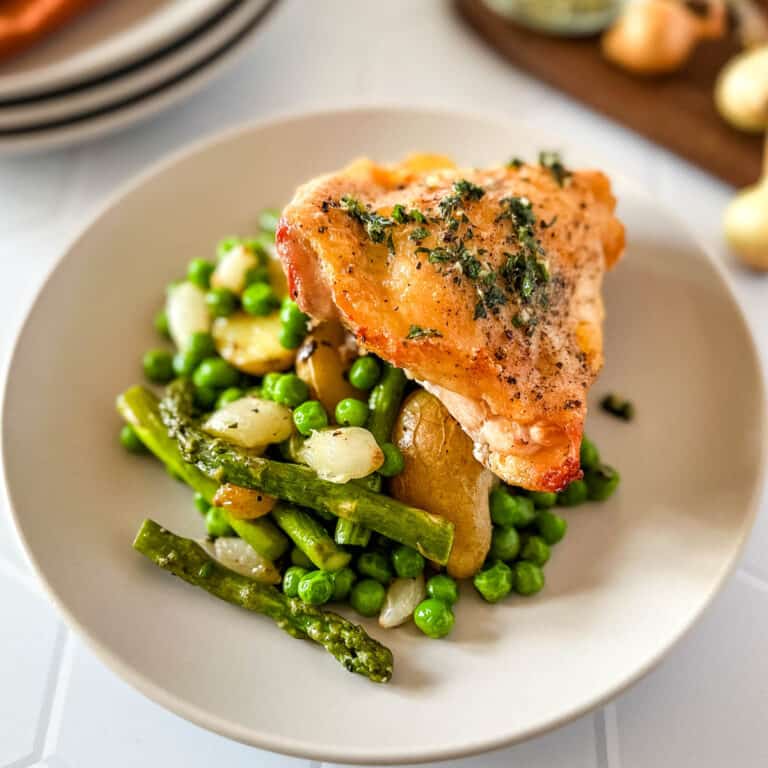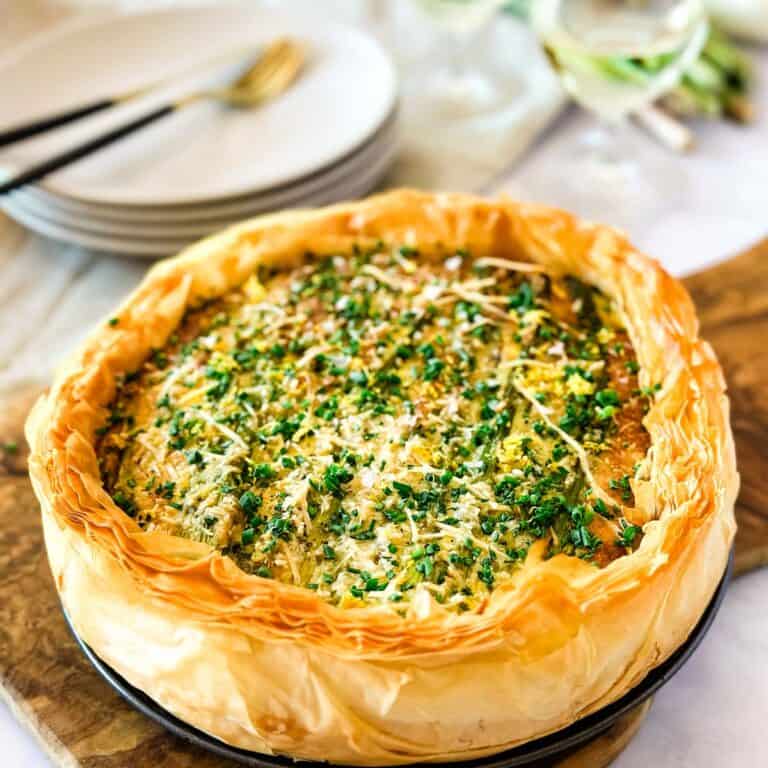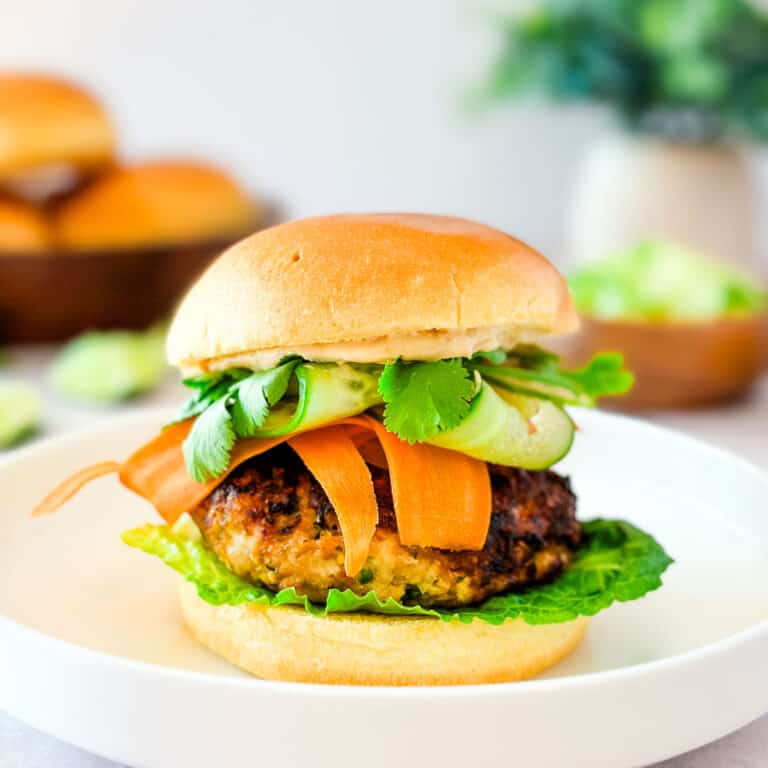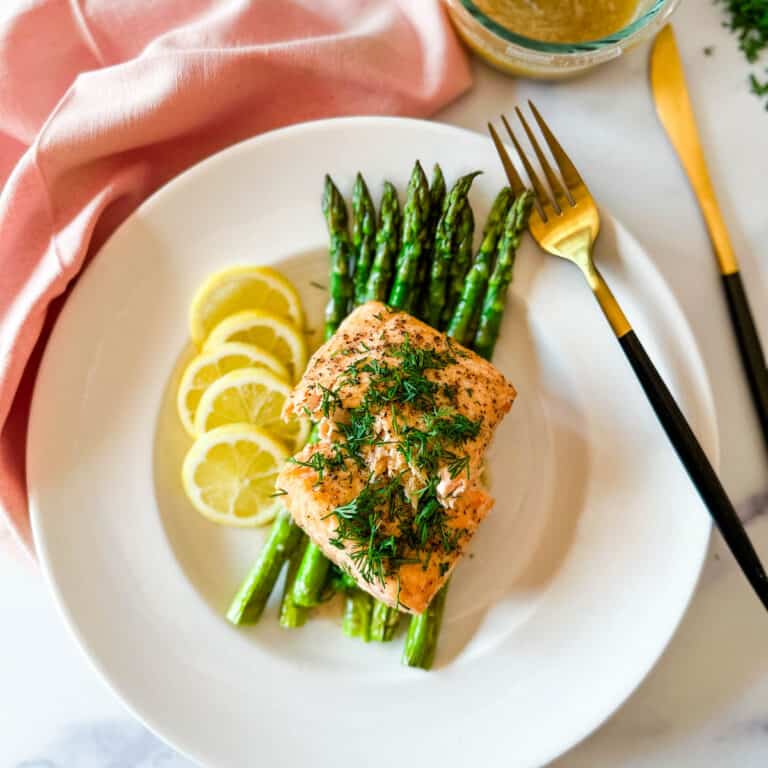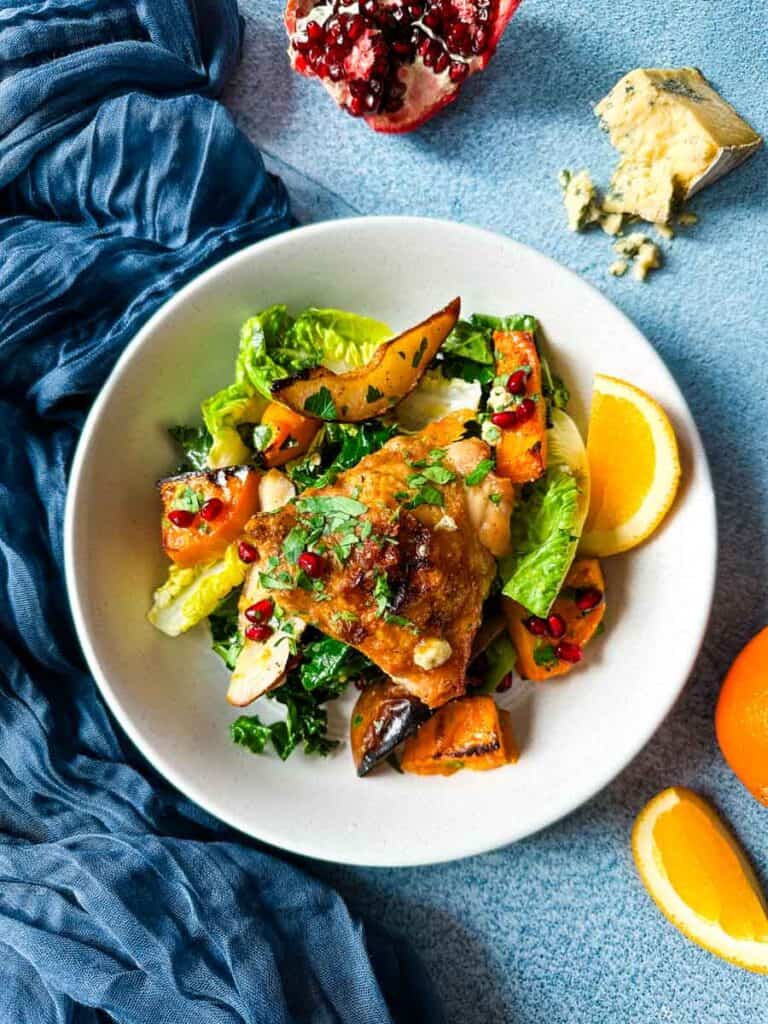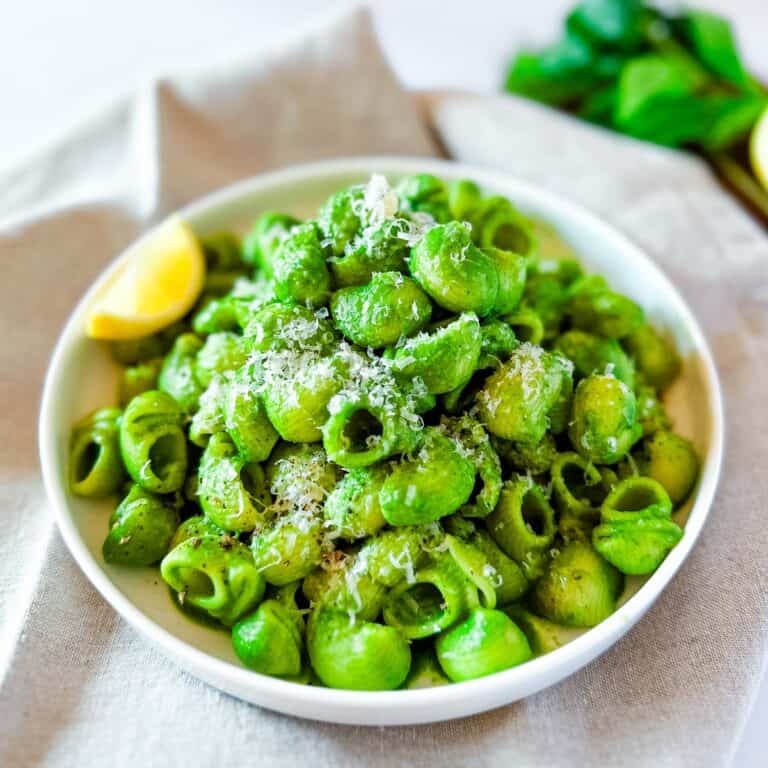Slow Roasted Salmon with Spring Herb Sauce
Even cooking, perfect texture, and superior moisture retention are the incredible features of this Slow Roasted Salmon with Spring Herb Sauce. Paired with a bright and tangy sauce, and done in 30 minutes, this dish is as well-suited to a weeknight as it is to a dinner with friends.
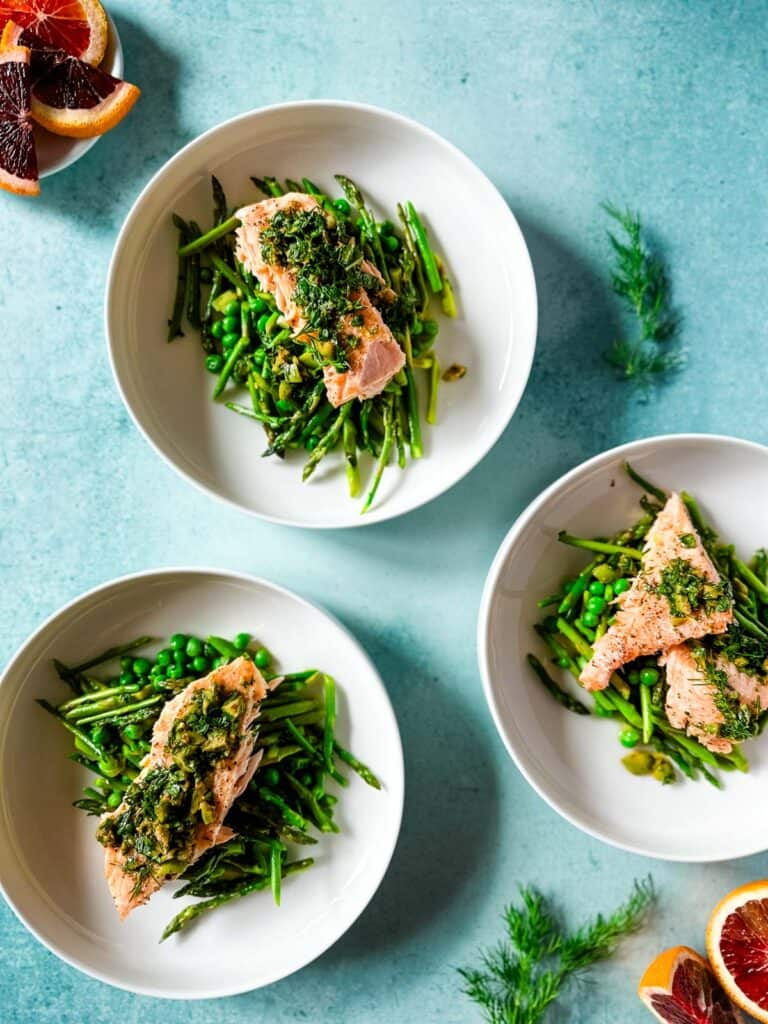
If you’re looking for another recipe utilizing this slow roasting technique, check out this Slow Roasted Salmon with Fennel and Citrus!
What you’ll love about this recipe:
Recipe ingredients
You’ll need the following ingredients to make this amazing Salmon roasted in the oven:

Ingredient Notes
The ingredients to make this slow roasted salmon are easy to find and readily available at most any grocery store. If you’re able, I would highly recommend grabbing anything you can at your local farmer’s market for maximum flavor.
Here are a few ingredient notes:
Salmon – center cut is best for the most even cooking, but is not absolutely necessary. Definitely make sure your salmon is in one piece.
Fresh herbs – this recipe calls for basil, mint and dill, but you can change it up if you like. Just be sure to use fresh and not dried!
Castelvetrano olives – these wonderful olives are mild, fruity and have an almost buttery texture – they are so good in this sauce. You can substitute another olive if you need to, but I highly recommend the castelvetrano olives if you can get them.
What is slow roasting and why do it?
Slow roasting is cooking something slowly in the oven at a very low temperature – typically between 225-275 degrees Fahrenheit. ‘Low and slow’ might make you think of barbecue, but the same logic applies here.
Why do we slow roast? Easy answers here: even cooking and fantastic moisture retention. When the heat is low, less moisture is lost from whatever you’re cooking – this results in an evenly cooked, juicier finished product. *Bonus: It is almost impossible to overcook something that is being slow roasted.
What are the best things to slow roast? Well, in the case of this recipe, fatty fish like salmon and cod are perfect. Also, tougher cuts of meat are also well-suited for slow roasting, as the long cook time and gentle temperatures help break down the connective tissues and result in meltingly tender meat.
How to make Slow Roasted Salmon with Spring Herb Sauce: STEP BY STEP
Be sure to check out the full recipe and ingredient list in the recipe card below
Step 1: Preheat the oven to 250 degrees Fahrenheit. Gently rub the salmon with 1 tablespoon of olive oil and season with kosher salt and black pepper. Roast for 25 minutes.
Step 2: Chop the herbs and olives and combine with the rest of the sauce ingredients. Mix well and set aside.
Step 3: Remove the salmon from the oven and top with the herb sauce.




Chef Notes & Tips
- Keep the salmon in one piece for the softest texture, the best moisture retention, and the most even cooking.
- The best way to know when the salmon is done, is to flake it gently with a fork or you can press it with your finger. It’s important to note that the salmon will not look very different when its finished – it may still look a little translucent in the center, but this is just because the temperature was so low, and it is indeed cooked. You can also check the temperature with a thermometer in the thickest part of the filet – it should register 125 degrees Fahrenheit for medium doneness.
- Resist overcooking the salmon!
- When making the herb sauce, be sure to chop the herbs with a sharp knife. No need to chop them until they are finely minced. Herbs with soft leaves, like basil and mint, become bruised when chopped too much and/or with a dull knife. This leads to a muddier flavor and a less pleasant texture.
Storage & Reheating
STORAGE: Store any leftover salmon and sauce in an airtight container for up to 3 days in the refrigerator.
REHEATING: To reheat the salmon, add it to a baking dish with a splash of water and cover it with aluminum foil. Add to a 350 degree oven until warmed through. Alternatively, you can also reheat it in the microwave in 30 second intervals until warmed through.
FREEZING: You can freeze the salmon in an airtight container for up to 3 months. The herb sauce is not suitable for freezing.

Additions & Substitutions
ADDITIONS:
Sugar/brown sugar – Add a teaspoon of sugar to the salt and pepper rubbed onto the salmon before roasting for an added dimension of flavor.
Chives – Fresh chives would make a nice addition to the sauce. You can add them or substitute them for one of the other herbs in the sauce.
Mayonnaise/Sour cream – You could add a creamy texture element to the sauce and blend it to give it a more ‘green goddess’ kind of feel.
SUBSTITUTIONS:
Fresh herbs – Substitute any fresh herbs for the ones in the recipe, but do not substitute dried herbs.
Olives – You can substitute any kind of Greek or Spanish briny olive, but I would not recommend substituting black olives in this.
White wine vinegar – Champagne vinegar, sherry vinegar or red wine vinegar would all make good substitutes.
Orange – You can easily substitute lemon for the orange.
Salmon – If you need to, you can substitute another fatty fish like cod, arctic char or mackerel, but you may need to adjust the cooking time according to the thickness of the fish.

FAQs
I hope you love this Slow Roasted Salmon with Spring Herb Sauce! If you make it, be sure to leave a rating so I know how you liked it!

Slow Roasted Salmon with Spring Herb Sauce
Ingredients
- 1 lb salmon filet (in one piece)
- 1 tbsp olive oil
- 1 tsp kosher salt
- 1/2 tsp black pepper
Herb Sauce
- 3 tbsp mint (chopped)
- 3 tbsp basil (chopped)
- 3 tbsp dill (chopped)
- 1/4 cup castelvetrano olives (chopped)
- 1 orange (zest & juice)
- 1 tsp white wine vinegar
- 1/2 tsp red chili flakes
- 1/2 cup olive oil
- 1/2 tsp kosher salt
Instructions
- Preheat the oven to 250 degrees.
- Place the salmon on a sheet pan and rub it on both sides with 1 tablespoon of olive oil and season with kosher salt and freshly ground black pepper.
- Roast in the oven for 25 minutes or until the fish flakes easily when you gently press on it. Alternatively, you can use a thermometer inserted into the thickest part of the filet – 125 degrees Fahrenheit for medium is recommended. *Please note that because you are cooking at such a low temperature, the appearance of the salmon will not be much different when it is finished.
- While the salmon is roasting, combine all of the sauce ingredients in a bowl and mix well. Set aside.
- When the salmon is done, drizzle it all over with the sauce and then use a large serving fork to flake apart portions to serve.
Nutrition
Did you make this recipe?
Mention us @nataliemarblecooks so we can see your creations! You can also leave a comment below!
